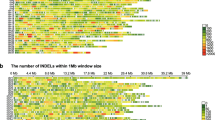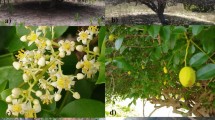Abstract
Exorista sorbillans is a tachinid endoparasitoid of silkworm, Bombyx mori, and is globally known as uzi. It causes economic injury to the cocoon crop in silkworm cultivating areas of India, except those above 400 m above mean sea level (AMSL) in the foothills of the Himalayas (Darjeeling). It is reported that the sericulture tract of south India became infected with this pest only since 1980 through an accidental transportation of cocoons from West Bengal. To ascertain whether the genome of this parasitoid is differentiating into discrete gene pools in contrasting geo-climatic conditions, molecular profiling of four populations (Es Annatapur, EsRamanagaram, Es Channapatna and EsKodathi from south India and EsMurshidabad from Murshidabad, West Bengal was undertaken with 13 ISSR, 3 RAPD and six non-random primers designed from various repeat sequences of B. mori . MANOVA indicated significance for the Roy’s largest root estimate (55.4; F =18.47; p = 0.002) for the variability contributed by the replication. Further, hierarchical clustering done on the basis of Euclidean distance matrix and Nei’s unbiased Phylip clustering put EsMurshidabad at the maximum distance from those of south India and 29 markers could also be identified which significantly differentiateEsMurshidabad from others. However, Nei’s statistics for gene diversity in sub-populations reveal considerably high gene-flow (3.44 and 2.51) among the populations around Bangalore. The gene-flow between EsMurshidabad and other population is lowest but cannot be ignored. The comparison of endosymbiont specific 16SrRNA and fts Z gene (partial) sequences through clustalW (gcgMSF) revealed a closer relationship of EsMurshidabad withEsAnnatapurand Es Ramanagaram and is not congruent with the relationships discussed above. The significance of this maiden study with a tachinid fly-pest is discussed in the context of understanding the diversification of Uzi fly-pest and also establishing this pest as a relevant biological material for studying microevolution in future.
Similar content being viewed by others
References
H. Abe F. Ohbayashi T. Shimada T. Sugasaki S. Kawai T. Oshiki (1998) ArticleTitleA complete full-length non-LTR retrotransposon, BMC1, on the W chromosome of silkworm, Bombyx mori Genes Genet. Syst 73 353–358 Occurrence Handle10.1266/ggs.73.353 Occurrence Handle10333566
R.M.H. Arafeh Y. Sapir A. Shmida N. Iraki O. Fragman H.P. Comes (2002) ArticleTitlePatterns of genetic and phenotypic variation in Iris haynei and I. Atrofusca (Iris sects. Oncocyclus=the royal irises) along an ecogeographical gradient in Israel and the West Bank Mol. Ecol 11 39–54 Occurrence Handle10.1046/j.0962-1083.2001.01417.x Occurrence Handle11903903
D.N. Basu G.S. Guha (1996) Agroclimatic Regional Planning in India, Vol. III Cocept Publishing Co New Delhi
D.A. Baum R.L. Small J.F. Wendel (1998) ArticleTitleBiogeography and floral evolution of baobabs (Adansonia , Bombacaceae) as inferred from multiple data sets Syst Biol 47 181–207 Occurrence Handle10.1080/106351598260644 Occurrence Handle12064226
C.F.C. Beeson S.N. Chatterjee (1935) ArticleTitleThe biology of Tachnidae (Diptera) Ind. For. Rec 1 169–184
B.P. Bradley (1980) ArticleTitleDevelopmental stability of Drosophila melanogaster under artificial and natural selection in constant and fluctuating environments Genetics 95 1033–1042 Occurrence Handle6781983
M.P. Breto C. Ruiz J.A. Pina M.J. Asins (2001) ArticleTitleThe diversification of Citrus clementina Hort. ex Tan., a vegetatively propagated crop species Mol. Phylogenet. Evol. 21 285–293 Occurrence Handle10.1006/mpev.2001.1008 Occurrence Handle11697922
C.R. Brown M.B. Brown (1998) ArticleTitleIntense natural selection on body size and wing and tail asymmetry in cliff swallows during severe weather Evolution 52 1461–1475
D. Bruckner (1975) ArticleTitleThe influence of genetic variability on wing symmetry in honeybees (Apis mellifera) Evolution 30 100–108
W.D. Burke C.C. Calalang T.H. Eickbush (1987) ArticleTitleThe site-specific ribosomal insertion element type II of Bombyx mori (R2Bm) contains the coding sequence for a reverse transcriptase-like enzyme Mol. Cell. Biol. 7 2221–2230 Occurrence Handle2439905
D. Charlesworth S. Wright (2001) ArticleTitleBreeding system and genome evolution Curr. Opin. Genet. Develop. 11 685–690 Occurrence Handle10.1016/S0959-437X(00)00254-9
S.N. Chatterjee T.P. Mohandas (2003) ArticleTitleIdentification of ISSR markers associated with productivity traits in silkworm,Bombyx mori L Genome 46 1–10 Occurrence Handle10.1139/g03-024 Occurrence Handle12669791
S.N. Chatterjee T.P Mohandas Taraphdar Tanushree (2003) ArticleTitleMolecular characterization of the gene pool of Exorista sorbillans (Diptera: Tachinidae) a parasitoid of silkworm, Bombyx mori , in India Eur. J. Entomol. 100 195–200
Chatterjee, S.N. & Tanushree Taraphdar, 2004. Molecular profiling of silkworm biodiviersity in India: an overview. Russ. J. Genet. 40.
A. Civetta R.S. Singh (1998) ArticleTitleSex and speciation: genetic architecture and evolutionary potential of sexual versus nonsexual traits in the sibling species of the Drosophila melanogaster complex Evolution 52 1080–1092
C.P. Clausen (1940) Entomophagous Insects McGraw-Hill, Book Company, Inc New York 688
S. Coulibaly R.S. Pasquet R. Papa P. Gepts (2002) ArticleTitleAFLP analysis of the phenetic organization and genetic diversity of Vigna unguiculata L. Walp. Reveals extensive gene flow between wild and domesticated types Theor. Appl. Genet. 104 358–366 Occurrence Handle10.1007/s001220100740 Occurrence Handle12582708
M.E. D’Amato D. Corach (1997) ArticleTitleRepetitive DNA sequences as an insight into Aeglidae (Crustacea, Anomura) evolution Electrophoresis 18 1666–1671 Occurrence Handle10.1002/elps.1150180933 Occurrence Handle9378142
A.P. Davierwala K.V. Chowdari S. Kumar A.P. Reddy P.K. Ranjekar V.S. Gupta (2000) ArticleTitleUse of three different marker systems to estimate genetic diversity of Indian elite rice varieties Genetica 108 269–284 Occurrence Handle10.1023/A:1004160232679 Occurrence Handle11294614
I.K. Dawson A.J. Simons R. Waugh W. Powell (1995) ArticleTitleDiversity and genetic differentiation among subpopulations of Gliricidia sepium revealed by PCR-based assays Heredity 74 10–18 Occurrence Handle7531677
H. Fischer-Le Saux H. Mauleon P. Constant B. Brunel N. Boemare (1998) ArticleTitlePCR-ribotyping of Xenorhabdus and Photorhabdus isolates from the Caribbean region in relation to the taxonomy and geographic distribution of their nematode hosts Appl. Environ. Microbiol 64 4246–4254 Occurrence Handle9797272
N.D. Gray R. Howarth A. Rowan R.W. Pickup J.G. Jones I.M. Head (1999) ArticleTitleNatural communities of Achromatium oxaliferum comprise genetically, morphologically, and ecologically distinct subpopulations Appl. Environ. Microbiol 65 5089–5099 Occurrence Handle10543827
C.C. Ghosh (1949) Silk Production and Weaving in India Monograph. Centre of Scientific and Industrial Research Govt. of India
J. Hess J.W. Kadereit P. Vargas (2000) ArticleTitleThe colonisation history of Olea europa L. in Macaronesia based on internal transcribed spacer 1 (ITS-1) sequences, random amplified polymorphic DNAs (RAPD), and intersimple sequence repeats (ISSR) Mol. Ecol 9 857–868 Occurrence Handle10.1046/j.1365-294x.2000.00942.x Occurrence Handle10886649
Jolly, M.S., 1981. Uzi fly, Its identification, prevention and control. CSRTI, Mysore, Karnataka, India. Bull. No. 4: 1–8.
S. Krishnaswamy M.N. Narasimhanna S.K. Suryanarayan S. Kumarraj (1973) Sericulture Manual II: Silkworm Rearing Food & Agriculture Organization United Nations, Rome
L.S. Kumar A.S. Savant V.S. Gupta P.K. Ranjekar (2001) ArticleTitleComparative analysis of genetic diversity among Indian populations of Scirpophaga incertulas by ISSR-PCR and RAPD-PCR Biochem. Genet 39 297–309 Occurrence Handle10.1023/A:1012252713056 Occurrence Handle11758726
J.A. Kwon W. Morden (2002) ArticleTitlePopulation genetic structure of two rare tree species (Colubrina oppostifolia and Alphitonia ponderosa, Ramnaceae) from Hawaiian dry and mesic forests using random amplified polymorphic DNA markers Mol. Ecol 11 991–1001 Occurrence Handle10.1046/j.1365-294X.2002.01497.x Occurrence Handle12030978
M. Madhu H.P. Puttaraju (2001) ArticleTitleCytological and molecular evidence for Wolbachia infection in Uzi flies of Exorista species Cytologia 66 197–203
S.T. Malcomber (2002) ArticleTitlePhylogeny of Gaertnera Lam. (Rubiaceae) based on multiple DNA markers: evidence of a rapid radiation in a widespread, morphologically diverse genus Evolution 56 42–57 Occurrence Handle11913666
J.M. McDermott B.A. McDonald (1993) ArticleTitleGene flow in plant pathosystems Ann. Rev. Phytopathol 31 353–373 Occurrence Handle10.1146/annurev.py.31.090193.002033
M.P. Miller (1997) Tools for population genetic analyses (TFPGA), Version 1.3 Department of Biological Sciences, Northern Arizona University Flagstaff
N.G. Mukherjee (1898) Hand Book of Sericuture Govt. Book Depot Calcutta, India
G.M. Nagaraja (2000) Genetic analysis of Bombyx mori L. using random amplified polymorphic DNA (RAPD) markers PhD thesis University of Mysore Mysore, India
S. Nakao S. Matsunaga A. Sakai T. Kuroiwa S. Kawano (2002) ArticleTitleRAPD isolation of a Y chromosome specific ORF in a dioecious plant, Silene latifolia Genome 45 413–420 Occurrence Handle10.1139/g01-151 Occurrence Handle11962638
K.C. Narayanaswamy M.C. Devaiah (1998) Silkworm Uzifly Zen Publishers Bangalore, India
K.C. Narayanaswamy P. Kumar D. Manjunath R.K. Datta (1994) ArticleTitleDetermination of flight range of uzifly, Exorista bombycis (Louis) (Diptera: Tachinidae) through marking technique by adding dye to adult diet Indian J. Seri 33 40–43
M. Nei (1973) ArticleTitleAnalysis of gene diversity in subdivided populations Proc. Natl. Acad. Sci. (USA) 70 3321–3323
M. Nei (1978) ArticleTitleEstimation of average heterozygosity and genetic distance from a small number of individuals Genetics 89 583–590
S.L. O’Neill R. Giordano A.M. Colbert T.L. Karr H.M. Robertson (1992) ArticleTitle16S rRNA phylogenetic analysis of the bacterial endosymbionts associated with cytoplasmic incompatibility in insects Proc. Natl. Acad. Sci. USA 89 2699–2702 Occurrence Handle1557375
S. Okazaki H. Ishikava H. Fjiwara (1995) ArticleTitleStructural analysis of TRAS1, a novel family of telomeric repeat-associated retrotransposons in the silkworm, Bombyx mori Mol. Cell. Biol 15 4545–4552 Occurrence Handle7623845
H.M. Robertson M.L. Asplund (1996) ArticleTitleBmmar1: a basal lineage of the mariner family of transposable elements in the silkworm moth, Bombyx mori Insect Biochem. Mol. Biol 26 945–954 Occurrence Handle10.1016/S0965-1748(96)00061-6 Occurrence Handle9014339
F. Rousset D. Bouchon B. Pintureau P. Juchault M. Solignac (1992) ArticleTitleWolbachia endosymbionts responsible for various alterations of sexuality in arthropods Proc. R. Soc. Lond. B. Biol. Sci. 250 91–98
S.S. Salimath A.C. De Olivera I.D. Godwin J.L. Bennetzen (1995) ArticleTitleAssessment of genome origins and genetic diversity in the genus Eleusine with DNA markers Genome 38 757–763 Occurrence Handle7672607
J. Sambrook E.F. Fritsch T. Maniatis (1989) Molecular Cloning: A Laboratory Manual EditionNumber2 Cold Spring Harbor Laboratory Press Cold Spring Harbor, New York
M.V. Samson (1980) ArticleTitleWar on uzifly Indian Silk 9 21–23
K. Sengupta P. Kumar M. Baig M. Govindaiah (1990) Handbook on Pest and Disease Control of Mulberry and Silkworm United Nations Economic and Social Commission for Asia and the Pacific Bangkok, Thailand
R. Sharma R.A.K. Aggarwal R. Kumar T. Mohapatra R.P. Sharma (2002) ArticleTitleConstruction of an RAPD linkage map and localization of QTLs for oleic acid level using recombinant inbreeds in mustard (Brassica juncea) Genome 45 467–472 Occurrence Handle10.1139/g02-001 Occurrence Handle12033614
M. Slatkin (1985) ArticleTitleGene flow in natural populations Ann. Rev. Ecol. Systemat 16 393–430 Occurrence Handle10.1146/annurev.ecolsys.16.1.393
H. Takahasi S. Okazaki F. Haruhiko (1997) ArticleTitleA new family of site-specific retrotransposons, SART1, is inserted into teleomeric repeats of the silkworm, Bombyx mori Nucl. Acids Res. 25 1578–1584 Occurrence Handle10.1093/nar/25.8.1578 Occurrence Handle9092665
F.M. Vander Wulp (1896) ArticleTitlePrasitic Muscidae from British India-3, Tricholyga bombycis Beck Indian Mus. Notes 3 8–15
J.H. Werren W. Zhang L.R. Guo (1995) ArticleTitleEvolution and phylogeny of Wolbachia : reproductive parasites of arthropods Proc. R.Soc. Lond. B Biol. Sci. 251 55–71
S. Wright (1931) ArticleTitleThe evolution in Mendelian populations Genetics 16 97–159
T.Z. Ye R.-C. Yang F.C. Yeh (2002) ArticleTitlePopulation structure of a lodgepole pine (Pinus contorta) and jack pine (P. banksiana) complex as revealed by random amplified polymorphic DNA Genome 45 530–540 Occurrence Handle10.1139/g02-016 Occurrence Handle12033622
Author information
Authors and Affiliations
Corresponding author
Rights and permissions
About this article
Cite this article
Chatterjee, S.N., Taraphdar, T. & Mohandas, T.P. Molecular Analysis of Divergence in Tachinid Uzi (Exorista Sorbillans) Populations in India. Genetica 125, 1–15 (2005). https://doi.org/10.1007/s10709-004-6192-0
Received:
Accepted:
Issue Date:
DOI: https://doi.org/10.1007/s10709-004-6192-0




